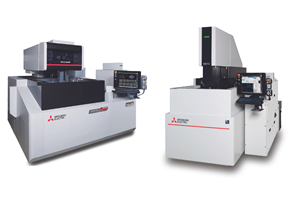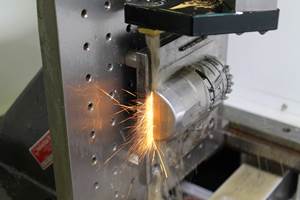Improved Break-Out Detection for Small-Hole EDM
The Current EDM RT6050 features software and hardware upgrades that improve the ability to detect when the electrode breaks out of the bottom of a hole.
Share






Quickly and precisely drilling small holes in very hard material is a strength of the electrical discharge machining (EDM) process. A long, slender electrode (0.015 inch in diameter or smaller) can penetrate tough aerospace alloys and other difficult-to-machine materials as fast as 20 inches per minute. One of the most important applications for this process is producing critical cooling holes in turbine and jet engine components. However, one persistent problem when producing these holes has been difficulty controlling the process to avoid over-drilling and striking the back wall of an internal cavity or passageway. At worst, “back-striking” can damage this wall and possibly cause a costly part to be scrapped. In any case, it slows the holemaking process and makes it less efficient.
Related Content
MC Machinery EDM Offerings Provide Optimized Performance
MC Machinery’s Mitsubishi SG12 and MV2400 EDMs provide ergonomic and efficient operations.
Read MoreBelmont Small-Hole EDM Features Multitasking Capabilities
The SY-4060 provides automatic depth control, three-step control of EDM parameters and conversational G- and M-code programming.
Read MoreMWI Introduces Wire EDM Consumables Designed to Maximize Energy Efficiency
Blac Technology’s specialized composition is designed to provide uniform distribution and embedding of particles throughout the surface.
Read MoreEDM Network Wire EDM Features Four-Axis Cutting
The EDMMax 434W fast-wire EDM includes four-axis cutting capability that enables it to cut 3D support structures or other shop-related parts.
Read MoreRead Next
Machine Shop MBA
Making Chips and Modern Machine Shop are teaming up for a new podcast series called Machine Shop MBA—designed to help manufacturers measure their success against the industry’s best. Through the lens of the Top Shops benchmarking program, the series explores the KPIs that set high-performing shops apart, from machine utilization and first-pass yield to employee engagement and revenue per employee.
Read MoreAMRs Are Moving Into Manufacturing: 4 Considerations for Implementation
AMRs can provide a flexible, easy-to-use automation platform so long as manufacturers choose a suitable task and prepare their facilities.
Read More


















